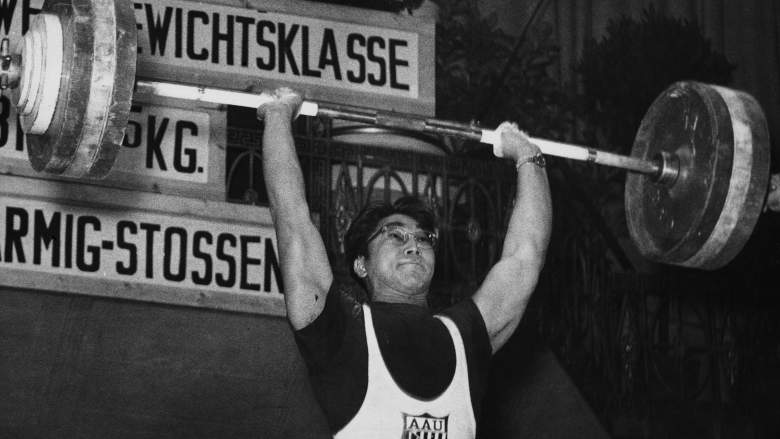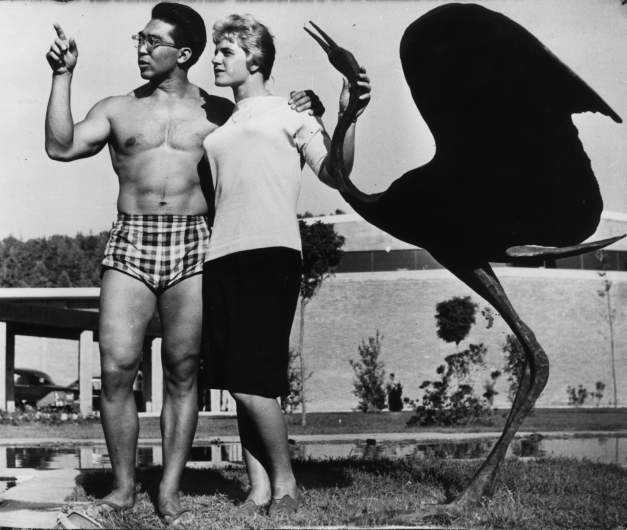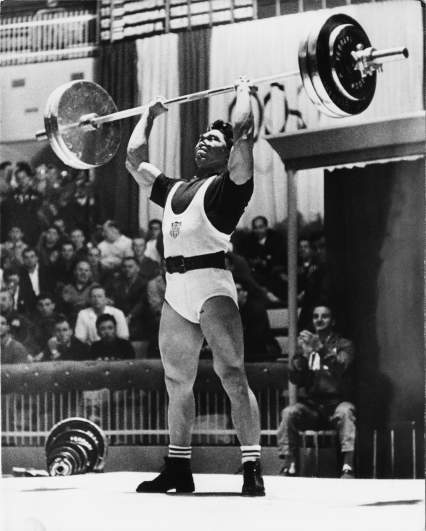
Tommy Kono was a legendary American weightlifter and Olympic gold medalist. He is being celebrated with a Google Doodle on what would have been his 91st birthday. Kono won multiple medals at the Olympics, along with several world championship titles, and became a successful coach after his career ended. He was born in California to a family of Japanese descent.
“Today’s Doodle, illustrated by Los Angeles-based guest artist Shanti Rittgers, celebrates Japanese-American coach, Olympic gold-medalist athlete, and world-champion bodybuilder Tommy Kono, who is regarded as one of the greatest weightlifters in United States history,” Google says. “After his 1964 retirement from a career gilded by 26 world records, along with dozens of championship titles in weightlifting and several in bodybuilding, Kono shared his seasoned expertise throughout the 70s as an Olympic coach. In 1993, Kono was inducted into the Weightlifting Hall of Fame, and to this day, Kono remains the only weightlifter in history to hold world records in four different weight classes.”
According to the Team USA Hall of Fame website, Kono is, “Considered by many to be the United States’ greatest weightlifter in history.” Google adds, “Happy birthday, Tommy Kono, and thank you for using your strength to lift not just weights, but those around you.”
Here’s what you need to know about Tommy Kono:
1. Kono Was Born in California & Spent Part of His Childhood in a Japanese Internment Camp in California, Where He First Discovered Weightlifting
He was born Tamio Kono in Sacramento, California, on June 27, 1930, according to the Google Arts & Culture project, “Indomitable: The Tommy Kono Story.” When Kono was 12, he and his family were held in a Japanese internment camp during World War II. He and his family were there from 1942 until 1945. Kono graduated from Sacramento High School after they were released and he spent time studying at Sacramento Junior College and working at the California Department of Motor Vehicles before his athletic career started, according to the Google project.
Kono discovered weightlifting while he was being held at the Tule Lake internment camp, according to The Olympians. He told the website, “There was nothing there (to distract me). No stuff hindering me. You have to understand when you’re in Tule camp you are like everybody else. I got to be in pretty good shape.”
According to the Google Doodle page celebrating Kono, “When the fog of war lifted, Kono returned home to Sacramento, where he entered his first weightlifting competitions. By 1952, he was an invaluable member of the U.S. national weightlifting team, in part due to his rare ability to move between weight classes without losing his strength.”
Kono was drafted to serve in the Korean War in 1950, but his athletic prowess and Olympic hopes kept him from serving overseas, according to The Washington Post. The newspaper wrote, “Kono was about to be sent to the front lines of the Korean War when his superior officers recognized his talent as a weightlifter. Instead, he was assigned to a base near San Francisco, where he trained for the 1952 Summer Olympics in Helsinki.”
2. Kono Won Gold Medals at the 1952 & 1956 Summer Olympics & Won the Silver Medal at the 1960 Olympics
Kono won his first gold medal at the 1952 Summer Olympics and broke the world record in the snatch at the Helinski games, according to his biography on the Team USA website. He won his second Olympic gold medal four years later at the 1956 Summer Olympics in Melbourne, competing in the light-heavyweight category. In 1960, at the Summer Olympics in Rome, Kono took home the silver medal in the middleweight category.
According to his Team USA bio, “across his career, Kono set 37 American, eight Pan American, seven Olympic and 26 world records. Upon retiring, Kono served as national weightlifting coach for Mexico, West Germany and the United States, and also worked as an International Weightlifting Federation coach and referee.” He was inducted into the Team USA Hall of Fame as an Olympian in 1990, according to the website.
“Standing only 5-foot-6, Kono competed in four different weight classes over the years and was the only lifter to set world records in all of them. He set records as a lightweight (for which the maximum at the time was 148.5 pounds), middleweight (165), light heavyweight (181) and middle heavyweight (198),” The New York Times wrote about Kono.
“Successful weightlifting is not in the body,” he said in 1960, according to The Washington Post. “It’s in the mind . . . You have to strengthen your mind to shut out everything — the man with the camera, the laugh or cough in the audience. You can lift as much as you believe you can.”
He told Sports Illustrated in 1954, “While you’re walking up there to the bar, you try to think of what you have to do. You try to concentrate to eliminate any noise going on. When I get there, I try to have a positive attitude. I try to think of myself lifting it—whether my back breaks or not.”
“If I concentrate hard enough, it’s actually like being in a room all by myself. There’s darkness all around, and all I have is the weight before me,” Kono added. “If I’m nerved up for the effort, I feel the weight for the first three or four inches. After that, I don’t feel the weight at all.”
3. Kono, Once Called the ‘Most Beautiful Athlete in the World’ by Sports Illustrated, Was Also a Bodybuilder & Was Named Mr. Universe 4 Times

GettyWeightlifter Tommy Kono and gymnast Doris Fuchs take a break from training at the Aqua Acetosa Stadium in Rome, on the eve of the Olympic Games in 1960.
Along with his career as an Olympian, Kono went on to become a bodybuilder, according to The Post Game. He won Mr. Universe titles in 1954, 1955, 1957 and 1961.
Kono told the Sacramento Bee in 2008, “When you go through hardship, it toughens you. It makes you better when you overcome that. This generation is the entitlement generation. They are not willing to work hard.”
According to The Washington Post, “In addition to his prowess as a weightlifter, Mr. Kono had a physique that prompted Sports Illustrated to dub him ‘the most beautiful athlete in the world.'” SI wrote in 1954, that Kono was “a soft-spoken Japanese-American with cat-quick reflexes and the title of The Most Beautiful Athlete in the World.”
4. Kono Inspired Arnold Schwarzenegger to Become a Bodybuilder
Kono was an inspiration to a young Arnold Schwarzenegger, according to The Olympians. Kono told the website, “In Europe, everybody lifts weights. It’s a common thing. Arnold was a weightlifter living on the outskirts of Vienna. He saw me in 1961. He was 13 years old. He decided that ‘if that little guy can win Mr. Universe, I could do that too.’ He started training hard, he won Junior Mister World, and eventually he won the big one.”
Ryan Yamamoto, a Seattle news anchor who produced the documentary Arnold Knows Me: The Tommy Kono Story, in 2016, told The Post Game when asked why more people don’t know about Kono, “You know I don’t like saying this, but it’s probably true that a lot of it has to do with race, Asian-American athletes weren’t celebrated. One, because there weren’t many of them, and two, because it just wasn’t of the psyche of society to celebrate them.”
Yamamoto added, “I think if Tommy Kono was doing what he did back then right now, he would be a star, but he was kind of forgotten back then. You have to remember back in the 50s, the Japanese were still not fondly looked upon in America. We’re less than a decade out of World War II, and you know, there was probably still a stigma at that time. It’s interesting because he would never talk about [his lack of attention], he was very humble about that, but I think deep down he maybe thought the same thing, that he didn’t get the credit that he was due.”
5. Kono, Who Was Named the ‘Lifter of the Century,’ Died in 2016 at Age 85 & Was Survived by His Wife, Children & Grandchildren

GettyTommy Kono in 1960.
Tommy Kono died on April 24, 2016, in Honolulu, Hawaii, from complications of liver disease, according to the Honolulu Star-Advertiser. He was 85. “He is in my opinion the greatest weightlifter of all-time,” former Olympic weightlifter Pete George told the newspaper. “He would always go where the competition was the toughest. Some of us went where we thought we’d get a medal.”
According to The Washington Post, Kono was survived by his wife, Florence Rodrigues Kono, and his three children and three grandchildren. Kono and his family had been living in Hawaii at the time of his death.
Artie Dreschler wrote in a tribute on the USA Weightlifting website after Kono’s death, “I had the enormous privilege of knowing Tommy for just shy of 40 years, meeting him as a young lifter anxious to learn from one of my heroes. Many young people idolize someone from afar, only to be disappointed when they actually meet their hero. That certainly happened to me on multiple occasions. But not with Tommy Kono. As I got to know him and became his friend, he continuously surpassed my lofty image of my idol, making in impression on me forever, with his expressions of his love for the game.”
Dreschler added, “While those who never met Tommy will never fully appreciate his full measure, we can all be grateful that his books and other writings captured at least some of his wisdom and character for all time. Tommy would have had many invaluable messages for the lifters of today and the future, had he been with us longer. But I feel confident that the one message he would have wanted to leave with us all was one that we talked about during our last conversation before his passing. He fervently wished and believed above all else – that USA weightlifters can be among the best in the world once again. They can do it if they only come to believe they can, and train intensely and intelligently to realize that level of performance. I hope the young lifters of today will have the courage and dedication to heed Tommy’s message, and grant him his last wish.”